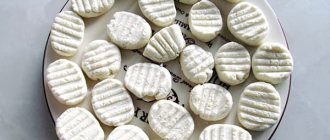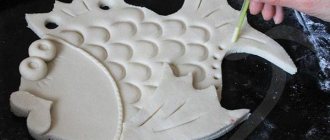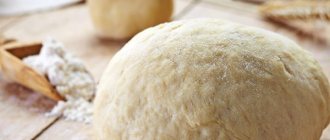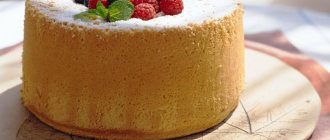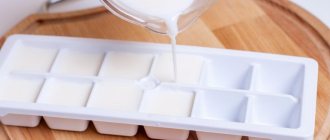This article is a fragment of a lesson from the Good Housewife Cooking School. Topic: freezing dough and baked goods.
It happens that buns or pies, prepared with such love and care, are not eaten by family members, and after a couple of days they no longer become so tasty. What to do? Baking half a portion is not economical: it takes a lot of time, but in the end you only end up with 5-7 buns.
What to do? Baking half a portion is not economical: it takes a lot of time, but in the end you only end up with 5-7 buns.
There is an exit! Even as many as three: you can and should freeze ! These are the beautiful and golden brown buns I got from frozen preparations.
What can you freeze?
You can freeze:
- yeast dough;
- finished molded products;
- ready-made baked goods.
We will talk about the second option, namely about freezing blanks for buns made from yeast dough and baking these same blanks .
You can use any dough recipe, but keep in mind that the filling for buns or pies must withstand freezing well .
I do not recommend freezing products with potatoes, cabbage, juicy fillings and those that will release a lot of liquid when defrosted. In this case, the bottom of the product will get wet and sticky, which will subsequently affect the taste and how well the buns bake.
Useful tips
Long shelf life dough
Certain types of dough can sit on the refrigerator or freezer shelf for a very long time. This applies to unleavened, flaky, yeast-free, custard, honey, ginger and gingerbread products. A prerequisite for such a semi-finished product is the absence of perishable products in the composition.
When frozen, such a mixture can retain its qualities for six months.
Freezing stages
- You can prepare the dough according to the recipe that I used to prepare them, and you will also find step-by-step photos on molding there. As a filling, I used thick jam, which cuts well, does not get soggy and does not leak out after baking.
2. In order to freeze the buns, you need to line a small tray or board with cling film and place the molded pieces on it .
3. Cover the top with a second layer of film, carefully tucking the edges . Do not leave the products open, otherwise they will dry out and the dough will not rise well. Place in the freezer.
Please note that open yeast dough loses moisture and seems to dry out, becoming less elastic and fluffy. For the same reason, I do not recommend pouring already frozen preparations into a bag, but if there is no other option, then wrap them as tightly as possible.
You should not leave the dough in the freezer for a long time; the quality of the finished buns will noticeably decrease. It is better to prepare a fresh batch of baked goods after a week or two.
4. When it becomes necessary to bake buns , you need to place the preparations on a baking sheet at a short distance from each other. Cover with a clean towel. You can moisten a towel with warm water, this will benefit the workpieces.
Some housewives defrost the preparations in the refrigerator, then leave them warm. I defrost at room temperature and defrost in a slightly warm oven.
See how the buns have expanded after defrosting while rising. The yeast works, but a little slower than if you bake buns without freezing.
I also noticed one feature: a slightly noticeable crust appears on the surface of the defrosted dough, which can become crispy during baking.
5. Now you need to grease the suitable buns with yolk, loosened with a little water, and bake at 180 degrees until browned.
How long does frozen dough last?
Properly frozen dough can be stored for up to three, maximum four months. The sooner it is used, the better the baked goods will turn out. If the refrigerator model has one common door for both chambers and, accordingly, the temperature in the freezer is not constant, then the dough should be put to work early, without waiting for the expiration date.
See also: Pancakes with milk
The shelf life is also shortened by a long absence of electricity, leading to temperature fluctuations.
If for some reason the dough is defrosted, it can no longer be re-frozen; it will have to be used.
Freezing in molds
I tried to freeze the following buns immediately in molds, in which they will then be baked. To do this, you need to roll out a layer of ready-made yeast dough, grease it with a suitable filling, again, which will not leak when defrosted.
Roll into a tight roll.
I used a mixture of softened butter, brown sugar and cinnamon. You can simply brush the dough with melted butter or vegetable oil, sprinkle evenly with sugar and spices or cocoa, nuts, grated chocolate, dried cranberries, raisins or candied fruits.
Cut the roll into discs, at least 2.5-3 cm thick. You need to cut with a sharp knife so that the layers of dough do not wrinkle.
Place the prepared products in a silicone mold. You can use muffin tins, a muffin tin, or a regular round tin, then you won't get individual buns, but something like a family pie, only with filling.
Wrap the mold very carefully with cling film so that the buns do not air out or dry out. Place the mold in the freezer.
I try to bake such a small number of buns on days when I'm cooking something else in the oven, such as a casserole or meat dish, so that I don't have to heat up the electric oven just for a few rolls. In 15 minutes you have fresh baked goods ready for a cup of tea or coffee.
You just need to take the mold out of the freezer in advance and let it stand on the kitchen counter. The shape prevents the buns from curling up on the sides. You can even not remove the film, but let the buns thaw and stand right under it.
Depending on the temperature in the kitchen, the buns will rise and fill almost the entire mold. Then you need to remove the film and grease the risen workpieces with yolk. If the kitchen is cool or there are drafts, it is better to put the buns in a warm oven for proofing (the yeast here is more sluggish, it will be more comfortable there). Bake the buns until golden brown.
You can take them out when they are baked, but still light golden, then they will be softer and more tender, or you can leave them a little longer when the sugar caramelizes and they become crispy and with a sticky top.
Recommendations
A few simple storage rules that modern housewives will need:
- The dough is susceptible to odors. Therefore, it needs to be placed on an empty shelf. It is better to move other products further away.
- The yeast mixture should not be left overnight, even if the room is cool. It may turn sour until the morning.
- If you get a large amount of mass, it is better to divide it into several parts to maintain the temperature regime.
- To avoid missing the expiration date, it is recommended to leave a note with the freezing date.
Even with proper storage, the yeast base can deteriorate.
The main signs of a poor quality product:
- the presence of an unpleasant and sour odor;
- texture change;
- the surface becomes sticky or slippery.
If after defrosting at least one of the above symptoms is present, the finished product must be discarded immediately.
Round buns
If you don’t really like crispy edges and crust in baked goods, then your option is round products without protruding edges and cuts. In fact, there is nothing there to dry out during baking, so the products remain as fluffy and soft as possible.
Form round buns, you can have them with filling, but I did them without it so that I could cut the buns and spread them with butter or jam.
For maximum effect, I placed the buns not immediately on the board, but in small molds.
You need to wrap the buns as carefully as possible in film and place them on a flat surface in the freezer.
When you're ready to bake, remove the pans of dough from the freezer and leave them on the kitchen counter. Do not remove the film. Let the dough thaw. You can place the buns on the same table if the kitchen is warm, or create more comfortable conditions for them in the oven so that the yeast is activated. Here you should focus not on the proofing time, but on the result. The dough balls should double in size.
The top of the buns can be greased with yolk or left as is, bake at 180 degrees until golden brown.
How to determine delay
To avoid misunderstandings and not spoil the impression of aromatic baked goods, adhere to the following recommendations:
- When purchasing a factory product, pay attention to the date of manufacture: choose the most recent product.
- The presence of a sharp sour or unpleasant odor indicates that the dough has lost its consumer value and has deteriorated.
- Make sure that the packaging is intact when purchasing: do not take it if it is swollen.
- Pay attention to the composition: if yeast, eggs, sugar are present, it will spoil faster.
- The appearance of a white slimy coating is characteristic of overdue delivery.
Option: we want to save already formed products
In this case, prepare the dough in the usual way. The only thing we need to change in the recipe is to use slow-acting yeast. A colony of bacteria that is rapidly developing will go through its life cycle and die out. And slow-acting yeast will continue to work after repeated kneading and settling. The cake pan should be greased with oil. Place the dough and filling there and wrap tightly in several layers of foil. Cover frozen yeast dough pies lying on a board with cling film. It wouldn’t hurt to sign when this homework was done. Let's put our products in the freezer. We have been using them for three months.
Option: we accidentally had leftover yeast dough
This case is the most difficult. After all, we could use both instant yeast and flour with low protein and gluten content. In addition, we went through all stages of working with the test. We let him rise, kneaded him, kneaded him, defended him. And then it turned out that a certain part of the test remained unused. How to save the product? Nothing could be simpler. Take plastic bags and lightly sprinkle the inside of them with flour. Divide the dough into portions and form into balls. We also roll them in flour and put each in its own bag. What is important: do not stuff the bags tightly. After all, the bacteria will not immediately realize that they are being frozen, and will continue to develop for some time. The risen dough may tear the bag. In this option we need a special temperature regime. Let's shock freeze the dough. Let's first set the camera to minimum. And then, when the dough in the bag turns into stone, you can increase the temperature to -15 degrees.
Answers:
Some types of dough and semi-finished products from it are perfectly frozen and stored: puff pastry - both yeast and yeast-free, in fact, straight yeast, chopped, shortbread and gingerbread. Yeast dough is frozen after the first rise and kneading. As a rule, dough prepared specifically for freezing requires a slightly larger amount of yeast, since some of the yeast cells die at extremely low temperatures. Like other types of products, the best freezing for yeast dough is shock freezing; the faster you freeze it, the less gas formation reaction (that is, loosening of the dough, its “growth”) will occur.
It is better to freeze puff pastry dough in finished products after partial proofing, so that your croissants do not lose their quality and appearance. This technique also reduces the proofing time after defrosting: sometimes such rolls and bagels are baked almost immediately after defrosting. But in general, the algorithm is simple: defrost, and then let the dough rise again, knead, shape, cover with a towel, rise - everything as usual.
Proper defrosting
It is necessary to spare bacteria and call them out of sleep gradually. If we simply take a piece of dough out of the freezer and defrost it at room temperature (or using hot water or heating in the microwave), then the baked goods will not please us with their taste. Let's do it differently. The day before you are going to bake the product, transfer the piece in the bag from the freezer to the refrigerator without unwrapping it. Then you can take it out of the bag and open it at room temperature. The dough should rise and increase in volume even more. Then we crush it and form the products. Baking from frozen dough turns out very tasty and is in no way inferior in quality to the one for which the base was just made.
How to freeze buns and yeast dough and bake them
It happens that buns or pies, prepared with such love and care, are not eaten by family members, and after a couple of days they no longer become so tasty

